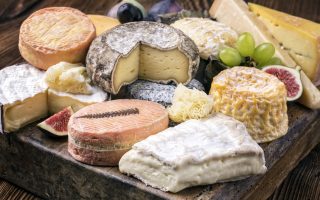Gourmet’s Tour of the Languedoc-Roussillon


There
I have pretty much travelled the length and breadth of the region eating and tasting along the way (hard job, but someone has got to do it) and so I now offer you this gourmet tour of the Languedoc-Roussillon, highlighting the delicious treats and hidden secrets that you’ll really want to look out for when you’re here.
As you will see, there’s something yummy to try in every department of the region; the tour starts with Provençal flavours in the Gard, will take us north to the hearty mountain foods of Lozère before heading south to the stunning seafood of the Hérault, then west ito the rural surprises of the Aude and then south again to the Catalan delights of the Pyrénées-Orientales!
So all that’s left for me to say is, of course, bon appétit!

Gard
Many would say that the Gard shares more with the neighbouring region Provence than the Languedoc-Roussillon to which it belongs, and indeed one often hears the term Gard Provençal applied to all sorts of things here. For me what really defines the cuisine here are the wonderful blends of herbs that fill the garrigue scrub that grows everywhere – oregano, thyme, savory, rosemary, marjoram and basil.
And between the garrigue are the lavender fields and the olive groves. The Gard is home to la Picholine: a green olive which was awarded AOC* recognition in 2006, not too long after the oil that is produced from it was also awarded that status (in 2004). So, the Picholine is now officially the “Olive de Nîmes” and is rather lovely – it has a deep green colour, its flesh is juicy, rich and has a very attractive crisp finish – perfect for aperitif time and also when used in the other local olive favourite, the tapenade olive spread. Head to the artisan market at Uzès for all your olive and herb requirements!
A visit to the Gard would also not be complete without heading into Nîmes to find the well-known Brandade de Nîmes. Also known as brandade de morue, it is a purée of salt cod, olive oil, and milk sometimes toped with a fine potato purée that tops the dish of mashed salt cod – delicious! And then for something quite different: the Camargue wetlands southeast of Nîmes, home of wild horses, pink flamingos and the famous black bulls. The adventurous meat-eater will want to sniff out a Gardiane de Taureau – a bull meat stew that has been simmered for about 3 hours having already been marinated for at least a day in a mixture of red wine, onions, vinegar, thyme, bay leaf, orange peel and garlic! This can be served with the sticky Camargue red rice, also known as riz rouge, for a thoroughly filling meal that should keep you going for days!
Lastly, it’s also good to know that the Gard department is the number 1 producer of asparagus in the whole of France! So you’ll get yours very fresh whilst you’re there, usually available between February and June.
Cévennes
I’ve decided to give the Cévennes area its own special section, partly because the mountain range for which it is named crosses the northern Gard and Hérault and the southern Lozère departments, and partly because these mountain people are so very passionate about their territory, its history and the food that is produced here. This extremely rural area is almost like the land that time forgot, and local produce is made here in the same way that it has been done for centuries.

The key thing here is the territory – as far as I’m aware there aren’t really any majorly famous dishes here – but the vegetables, the fruit, the meat, the cheese that this land produces are delicate, elegantly flavoursome, and pure heaven! So, when you’re here look out for the only European onion to have an AOC label – Cévennes sweet onions, l’oignon doux; the reinette apple from Vigan (great, by the way, for making a tarte tatin); the Pélardon goat’s milk cheese (also AOC protected); chestnuts; amazing honey from chestnut pollen; and Terres d’or lamb – which is bred according to traditional methods and so is only commercially available from the end of November to February and from the end of April to September. Also not to be missed – the completely unexpected and brilliant annual Soup Festival in Florac, usually towards the end of October.
Lozère
Even further north than the Cévennes is the truly rural paradise that is the Lozère department. You’d be forgiven for thinking that this northernmost part of the Languedoc-Roussillon had little in common with the rest of the region because, in fact, the Lozère was formerly part of the neighbouring Auvergne region. And whilst it seems you can change political boundaries at the drop of a hat, traditions – especially culinary ones – have much stronger bonds.
The foods that are made in the Lozère are strictly robust in flavour and purpose. There’s nothing remotely dainty or fussy here. It’s hearty, it’s honest and it’s very, very good! Amongst the highlights here, in this predominantly livestock and dairy farming land, are the cheeses. The Lozère produces five AOC cheeses: the Bleu des Causses, the Laguiole, the Pélardon (see above), the Bleu d’Auvergne and the famous Roquefort. Also good to try here are the many chestnut based products and the organic beef which is bred under a special charter to ensure that the animals are treated as humanely as possible, with every care taken to minimise stress and fear.
But perhaps the most interesting dish to try in the Lozère is the Aligot de l’Aubrac. Aligot is a dish that originated in the Aubrac area that spans the Aveyron, Cantal and Lozère departments. It is mashed potatoes that are mixed with crème fraîche, butter and fresh Tomme (a local cow’s milk cheese), almost always with some crushed garlic. The tradition is to blend and work the mixture until it reaches a highly elastic texture. It’s not to everyone’s tastes – but the intrepid foodie will certainly want to seek it out! Finally, make sure to squeeze in a trip to the bakers in Mende for a sweet treat in the form of the Croquants de Mende – a crunchy biscuit made with almonds – perfect for dunking into a big bowl of café au lait!

Hérault
Heading back south from the Lozère along the A75 into the Hérault department and everything gradually starts to get a bit more Mediterranean. Gone are the sweeping, lush valleys and steeply pitched slate-roofed houses; in their place are vineyards as far as the eye can see, terracotta tiles and eventually, the sparkling blue sea itself. For sweet tooths, Hérault specialities include Berlingot hard-boiled sweets from Pézenas; the honey and liquorice based sweets from Montpellier called Grisettes that date back to the 1100s; and the orange flavoured Fougasse cake from Aigues-Mortes.
For those who prefer their treats to be more savoury, then you must go to Pézenas and try the legendary petit pâte sale-sucré. The legend goes that the British Lord Clive of India brought the recipe to Pézenas during a visit there in 1768. It is essentially a kind of pie – often shaped rather like a thread bobbin – and filled with a sort of sweet-sour-savoury mixture of lamb, suet, lemon zest, nutmeg, cinnamon and brown sugar. A very interesting concoction, though I don’t know how much I believe the Clive of India story!
But seriously, for a distinctly Mediterranean taste from the Hérault, you have to go to the Bassin de Thau. This immense saltwater lagoon south of Montpellier is where the seafood industry of the region is located – predominantly for mussels and oysters and best tasted with a glass of the locally produced Picpoul de Pinet. For more alcoholic loveliness, the little port town of Marseillan is home to the wonderful Noilly Prat vermouth cellars – a visit to the cellars is a great way to start your gastronomic day in the area!
Head over to the lagoon-side village of a Bouzigues where you will find a swathe of seafood restaurants stocking fish and shellfish that have literally just arrived fresh from the boat (or farm). There’s also a very sweet museum here charting the area’s traditions. At the north end of the lagoon is the super cool seaside town of Sète – go here for more fantastic fish restaurants and to try the local delicacies, the Bourride de Baudroie (monkfish with aïoli), the Rouille (cuttlefish stew) and the Tielle (a sort of tomato and octopus pie).

Aude
I’m afraid the Aude department is rather lacking in local gastronomy than the other departments – and I’m not too sure why that is? Mind you, what little they do have to celebrate is worth the effort. The first, of course, is the Cassoulet, a centuries-old bean and meat stew that is hotly contested to have originated from Castelnaudary, Carcassonne or Toulouse. I rather favour the Castelnaudary version, and this is certainly the place where the stew is produced en masse for supermarket shelves across France. However, I would recommend seeking out a made-from-scratch non-canned version of cassoulet from a local chef – it will be abundantly more tasty. Or head over to Castelnaudary in the last weekend of August for the annual Cassoulet Festival and try several different versions then!
The second treat awaiting you in the Aude is the Blanquette de Limoux sparkling wine, which legend has it was discovered in a monastery in nearby Saint Hilaire and “stolen” by Dom Pérignon who developed the fermenting process and brought it to market in the Champagne region. Legends apart, the production of blanquette dominates wine production in the Limoux area, and you would be advised to visit several different cellars whilst you’re in the area to taste the different versions.
Finally, there are the truffles! Whilst truffles are available in other areas of the region, the truffle fair at Villeneuve-Minervois which occurs over three different weekends through December to February is a fantastic local event accompanied by pomp and ceremony, an artisan produce market, cookery demonstrations from award-wining local chefs and truffle dishes served at the local restaurants! Brilliant!

Pyrénées-Orientales
The Pyrénées-Orientales department – historically the Roussillon part of the region – is the most southerly of the region’s departments and borders with Spain. This is essentially French Catalonia and both the food and the people here are flavoured with Catalan passion. Naturally you should expect to find the delicious Crème Catalane – much lighter but similar to a Crème Brûlée, and usually distinguished with lemon, orange or cinnamon flavours. When made well this baked custard dish is simply divine and features on most restaurant’s menus here. Other sweet treats to look out for are the local Touron nougat – the standard version is made with honey and almond praline, but there are lots of different versions which mix in chocolate, coconut, dried fruit and such – and also the Rousquilles du Vallespir, lovely buttery biscuits covered with lemon flavoured icing.
The Roussillon is also famed for its fertile river plains that produce vast quantities of fantastic fruit – particularly cherries from the Céret area. The area is also particularly and rightly proud of its wine making industry – and of special note are the fortified and sweet wines made here: Banyuls, Maury, and Muscat de Rivesaltes. All of which are excellent with apéritif or dessert. Also good to know is that the market town of Thuir is home to one of the Pernod Cusenier distilleries, the Caves de Byrrh, where a number of exotic apéritifs are still produced including the rather unique aromatic Byrrh itself.
Finally, no visit to the Pyrénées-Orientales can be complete without a taste of the Mediterranean that edges its eastern coast. There are lots of really excellent fish restaurants here, especially in Port-Vendres, the largest fishing port in the department; and a short trip up the coast from there is gorgeous Collioure – home to the celebrated anchovy industry that is known throughout France. Every step from fishing to filleting and conserving is done by hand; according to traditions going back to the Middle Ages!
Greca Sandford, 2010
* Appellation d’origine contrôlée (AOC), which translates as “controlled designation of origin” is the French certification granted to certain French geographical indications for wines, cheeses, butters, and other agricultural products.
Share to: Facebook Twitter LinkedIn Email
More in aude, auvergne, fishing, food, villages, wine, work
By FrenchEntrée
Leave a reply
Your email address will not be published. Required fields are marked *



